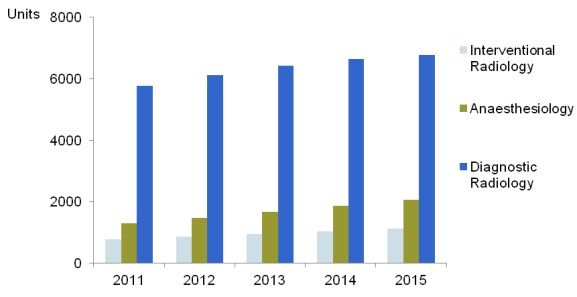Ultrasound in Interventional Radiology: Small Market, Big Future
With increasing economic pressures and concern regarding radiation dose, a safer and comparable alternative to CT and X-ray is being sought. Ultrasound may be the answer.
For many manufacturers, advancing ultrasound use in radiology has been a challenge. While new technologies have driven ultrasound use in other applications, such as heart wall motion diagnostics in cardiology and 3D/4D volume imaging in OB/GYN, many radiologists continue to use ultrasound for basic examinations only.
Nevertheless, recent advances in image quality, improved workflow, and rising concerns over radiation dose in other modalities, are re-igniting radiologist’s interest in ultrasound.
The interventional radiology (IR) market only accounted for 3 percent of global ultrasound revenues in 2011, according to InMedica, an independent market research firm, but has great future growth potential. Computed tomography and X-ray have been most widely used for IR procedures, on account of the clarity and resolution of the image guidance provided. With increasing economic pressures and concern regarding radiation dose, a safer and comparable alternative is being sought. Ultrasound may be the answer.
Fusion imaging is the key technology driver in the IR market. The incorporation of new advanced GPS positioning enables real-time feedback of needle position during interventional procedures, allowing highly accurate guidance. These advances in ultrasound procedural guidance are improving both the efficiency and quality of the procedure, providing further cost savings for hospitals.
The anaesthesiology sector is an example of how improved image quality, flexibility and favorable costs have driven increased use of ultrasound. While growth of the overall radiology ultrasound market remains slow, ultrasound in the IR market has potential to have the same success as in anaesthesiology, in which global unit shipments have grown between 10 percent and 15 percent annually in the last three years.
Recent developments in cardiac care have also led to new therapies integrating interventional and surgical procedures. Hybrid operating suites are used for these procedures, combining the conventions of a surgical operating room with imaging technology, such as X-ray, CT, MRI and ultrasound equipment. The increased use of hybrid interventional suites in developed and mature healthcare markets is driving initial demand and use of ultrasound equipment in IR.
Furthermore, technological advances in minimally invasive surgery are leading to greater need for imaging procedural guidance. Hybrid suites also have benefits for healthcare providers. In combining imaging with surgical suites, hospitals are able to reduce costs and increase efficiency. The patient is not subjected to multiple operations, the length of stay is reduced, and the overall cost of care is lower.
Hybrid suites are a major investment for hospitals, typically costing several million dollars. Yet, adoption of hybrid suites in the U.S. is already common. In the short term current economic concerns will limit wider penetration in other mature markets, due to economic concerns and healthcare expenditure freezes. Longer term, use of these suites in large hospitals will significantly increase in the next three to five years, due to the increased return on investment provided.
The increasing image quality, flexibility and cost savings offered by ultrasound will drive growth in the IR market. InMedica forecasts revenue growth between 4 percent and 6 percent globally for interventional radiology in 2012. Optimising technology of ultrasound fusion imaging may help to further drive growth in this market.
However, the on-going challenge in the IR market is convincing healthcare providers of the benefits of ultrasound, both in cost and quality of care. The clinical cost benefits associated with ultrasound have already been proven within other ultrasound applications; if the same can be done in IR, interventional ultrasound will quickly become standard practice.

U.S. Ultrasound Units by Application. Source: InMedica
Carly Reed is an analyst at InMedica, working within the medical imaging research group. Carly is responsible for the report, “The World Market for Ultrasound Imaging Equipment – 2012”, due to be published in April 2012.
What New Research Reveals About Novice Use of AI-Guided Cardiac Ultrasound
April 4th 2025In a study recently presented at the American College of Cardiology (ACC) conference, researchers found that novice use of AI-guided cardiac ultrasound after an AI-enabled electrocardiogram increased the positive predictive value for reduced left ventricular ejection fraction (LVEF) or aortic valve stenosis by 33 percent.
The Reading Room Podcast: Current Perspectives on the Updated Appropriate Use Criteria for Brain PET
March 18th 2025In a new podcast, Satoshi Minoshima, M.D., Ph.D., and James Williams, Ph.D., share their insights on the recently updated appropriate use criteria for amyloid PET and tau PET in patients with mild cognitive impairment.
Study with CT Data Suggests Women with PE Have More Than Triple the One-Year Mortality Rate than Men
April 3rd 2025After a multivariable assessment including age and comorbidities, women with pulmonary embolism (PE) had a 48 percent higher risk of one-year mortality than men with PE, according to a new study involving over 33,000 patients.
GE HealthCare Debuts AI-Powered Cardiac CT Device at ACC Conference
April 1st 2025Featuring enhanced low-dose image quality with motion-free images, the Revolution Vibe CT system reportedly facilitates improved diagnostic clarity for patients with conditions ranging from in-stent restenosis to atrial fibrillation.